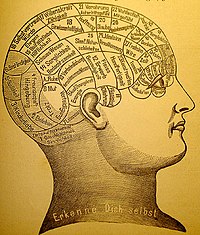Haydn's skull

The celebrated composer

Peter and Rosenbaum's motivation was an interest in phrenology, a now-discredited scientific movement that attempted to associate mental capacities with aspects of cranial anatomy; Peter and Rosenbaum were acquainted with and admired the work of Franz Joseph Gall, a leading phrenologist.[5] Of particular interest to phrenology was the anatomy of individuals held to have exhibited great genius during their lifetime. (Eighteen years later, a similar attempt was made on the body of Ludwig van Beethoven, possibly for similar reasons.)[6]
The head was stolen by the gravedigger (whose name was Jakob Demuth) only on June 4, and due to hot weather the head had decomposed considerably, causing Rosenbaum to throw up as he delivered it in a carriage to the hospital for dissection. According to Landon, "after an examination of an hour the head was macerated and the skull bleached."[7] Peter concluded that "the bump of music" in Haydn's skull was indeed "fully developed".[8] In September, the skull was installed in Peter's collection at his home, where it could be shown to visitors.[7] Peter kept it in a handsome custom-made black wooden box, with a symbolic golden lyre at the top, glass windows, and a white cushion. At some point in the ensuing decade, Peter gave up his skull collection and let Rosenbaum have, among others, the Haydn skull.[7]
In 1820, Haydn's old patron
Upon exhumation, they found a body with a wig above its severed neck. Haydn was in two. Nikolaus was enraged, and quickly deduced that Peter and Rosenbaum were responsible. [10]
However, through a series of devious maneuvers (blaming a deceased doctor, two fake skulls; one rejected) Peter and Rosenbaum managed to maintain possession of the skull. Rosenbaum hid the skull in a straw mattress. During the search of Rosenbaum's house, his wife Therese lay on the bed and claimed to be menstruating—with the result that the searchers did not go near the mattress.[11] Eventually Rosenbaum gave Prince Esterházy a different skull.
For a time, the skull sat on a piano at the Vienna Society for Friends and Music.

After Rosenbaum's death in 1829, the skull passed from hand to hand. Rosenbaum had willed the skull to Peter, who gave it to his physician Karl Heller, from whom it went to a Professor Rokitansky, who in 1895 gave it to the Vienna Gesellschaft der Musikfreunde (Society of the Friends of Music).[7] The musicologist Karl Geiringer, who worked at the Society before the advent of Hitler, would on occasion proudly bring out the relic and show it to visitors.[12]
In 1932, Prince
Notes
- ^ Webster (2002), p. 43
- ^ Geiringer & Geiringer (1982), p. 190
- ^ R (1932)
- ^ The marriage did ultimately take place in 1800, after Rosenbaum had left Esterházy employment. Rice (2009)
- ^ Landon (2009), p. 152
- ^ According to Beethoven's biographer, Anton Schindler, the gravedigger told him that he had turned down a bribe of 1000 florins for delivering the great composer's severed head. Albrecht (1996), p. 215
- ^ a b c d Landon (2009), p. 153
- ^ Geiringer & Geiringer (1982)
- ^ Specifically, to the Esterházy family crypt in the Bergkirche. Landon (2009), p. 153
- ^ The Ross, Greg (7 September 2015). "Futility Closet Podcast Ep 72". Futility Closet.
- ^ a b Hunting Haydn's Head, BBC Radio 4 broadcast by Simon Townley, 30 May 2009
- ^ Geiringer (1947)
- ^ M. M. S. (1948)
Bibliography
Note: except where specified, all information was taken from the final chapter of Geiringer & Geiringer 1982.
- Albrecht, Theodore (1996). Letters to Beethoven and Other Correspondence: 1824–1828. University of Nebraska Press. ISBN 0-8032-1040-X.
- Geiringer, Karl (1947). Haydn: A Creative Life in Music (1st ed.). London: Allen & Unwin.
- Geiringer, Karl; Geiringer, Irene (1982). Haydn: A Creative Life in Music (3rd ed.). ISBN 0-520-04316-2.
- Hadden, James Cuthbert (1902). Haydn. Master Musicians. London: J.M. Dent & Co.
- Landon, Else Radant (2009). "Haydn's skull". In Jones, David Wyn (ed.). Oxford Composer Companions: Haydn. Oxford: Oxford University Press.
- "M. M. S." (anonymous author) (April 1948). "Review of Geiringer, Haydn: A Creative Life in Music". Music & Letters. 29 (2): 179–82. )
- Pohl, Carl Ferdinand; Botstiber, Hugo (1878). Joseph Haydn (in German). Leipzig: Breitkopf & Härtel. Archived from the original on 2009-11-24. Retrieved 2009-06-09.
- "R." (anonymous author) (October 1, 1932). "The Skull of Joseph Haydn". The Musical Times. 73 (1076): 942–43. )
- Rice, John A. (2009). "Rosenbaum, Joseph Carl". In Jones, David Wyn (ed.). Oxford Composer Companions: Haydn. Oxford: Oxford University Press.
- Webster, James (2002). The New Grove Haydn. New York: St. Martin's Press.
Further reading
- "Haydn's skull is returned: After theft 145 years ago body is complete". Life. Vol. 36, no. 26. June 28, 1954. pp. 51–54.
